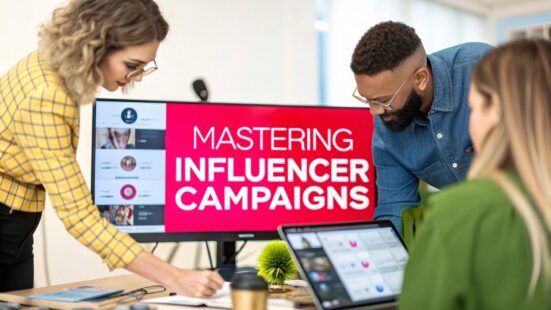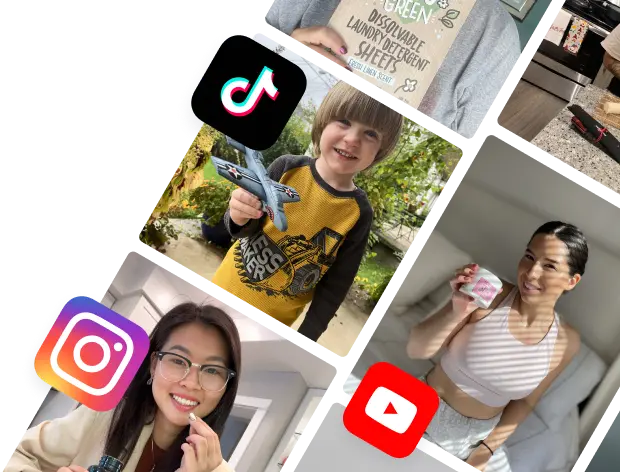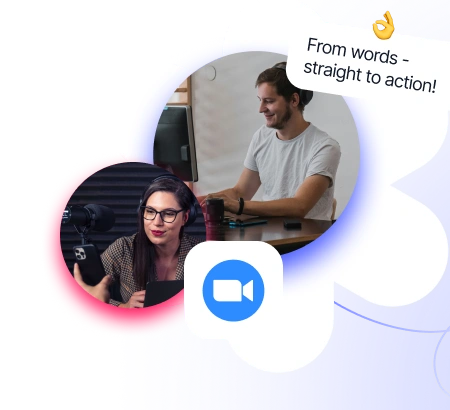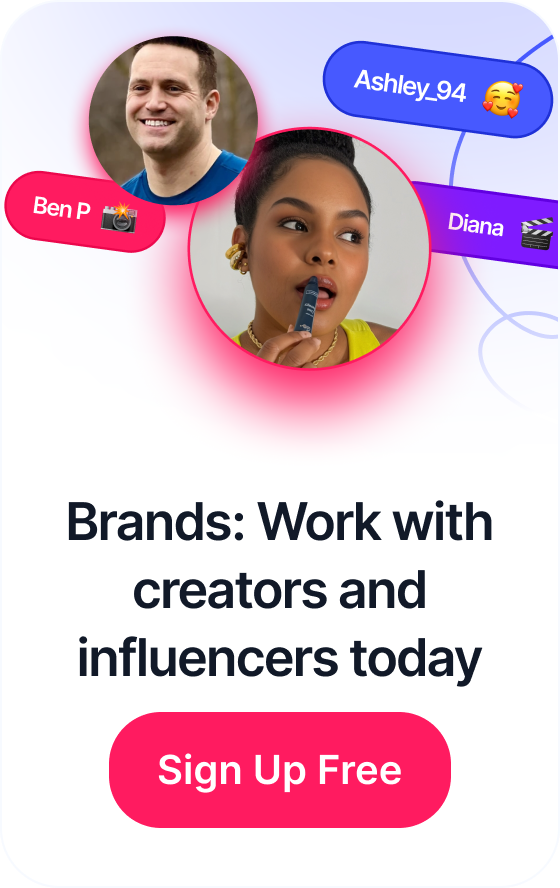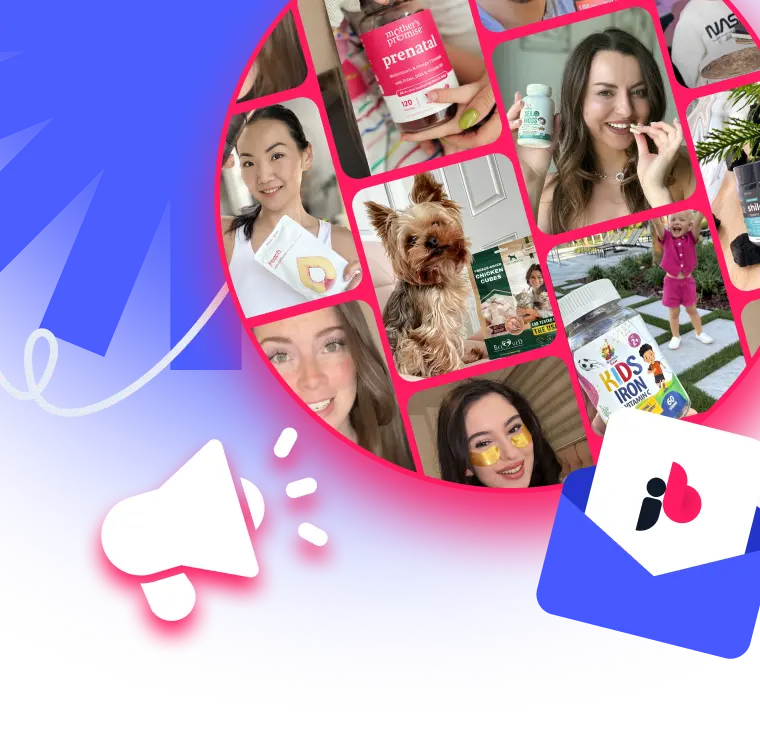 7 Influencer Marketing Examples to Boost Your 2025 Strategy
7 Influencer Marketing Examples to Boost Your 2025 Strategy
An effective influencer marketing campaign is way more than just a paid shoutout. Think of it as a strategic partnership designed to build genuine trust with the people you actually want to reach. In a world drowning in ads, these authentic creator collaborations are what cut through the noise. They focus on measurable results, like boosting sales and creating real brand loyalty, not just chasing empty metrics.
Table of Contents
Why Influencer Marketing Actually Works
Let's get past the hype and look at the real-world impact of a smart creator partnership.
At their core, successful influencer marketing campaigns tap into a simple, powerful concept: word-of-mouth, but at scale. When a creator an audience already trusts recommends a product, it doesn't feel like an ad. It feels like getting advice from a friend. That authenticity is the secret sauce for bypassing ad fatigue and forging real connections with potential customers.

This isn't just a fleeting trend; it’s quickly becoming a central pillar of modern marketing. The global influencer marketing industry is expected to hit a staggering $32.55 billion by 2025—a massive leap from just $10 billion back in 2020. This explosive growth shows just how much brands now rely on these partnerships, with over 80% of marketers confirming it's a highly effective channel for them. You can learn more about this industry growth and its impact here.
The Core Drivers of Success
The magic behind these campaigns boils down to a few core principles that traditional advertising just can't replicate. Once you get these, you can build a much more impactful strategy.
Here’s what really makes it tick:
- Targeted Reach: Influencers have already put in the hard work of building a dedicated community around a specific niche—whether it’s sustainable fashion, the latest tech gadgets, or vegan cooking. This lets your brand plug directly into a pre-qualified and highly engaged audience.
- Authentic Storytelling: Creators are master storytellers. They know how to weave products into their content in a way that feels natural and relatable. They can show off real-world uses, share personal experiences, and make your brand a seamless part of content their audience already loves.
- Building Social Proof: When several respected voices in a community all vouch for a product, it creates powerful social proof. That validation signals to consumers that your brand is credible and trustworthy, which is absolutely critical when it comes to influencing a purchase.
The real magic happens when a brand-creator partnership feels so natural that the promotional content provides just as much value to the audience as the creator's regular posts. That's the ultimate goal.
When it's all said and done, the benefits are crystal clear—from driving tangible sales to building a base of long-term brand advocates. This guide is your complete roadmap to harnessing that power, taking you from initial strategy all the way to final performance analysis.
Building Your Campaign Foundation
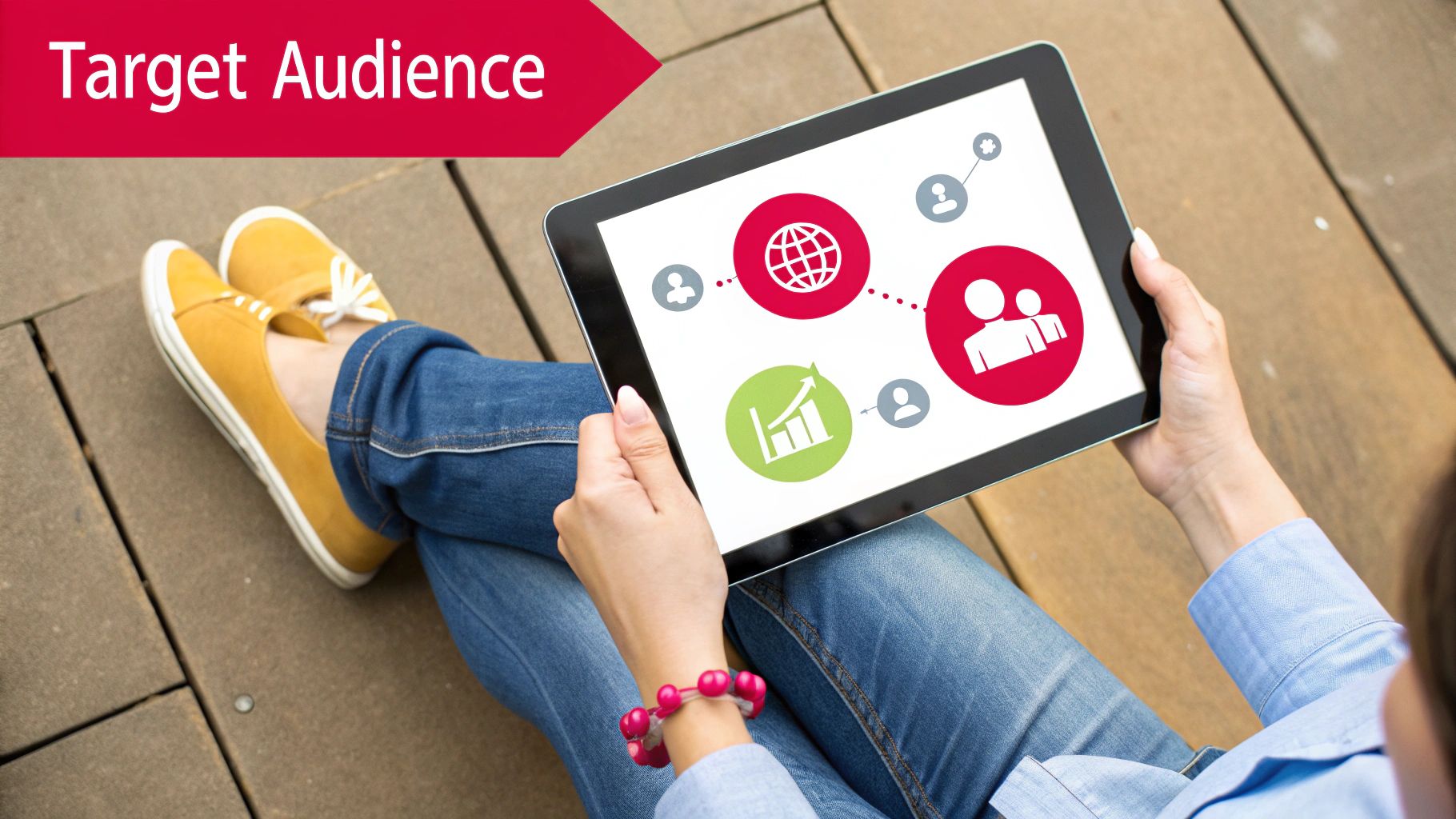
Before you even think about which creators to contact, the real work begins. The most successful influencer marketing campaigns aren’t built on viral luck; they're built on a rock-solid foundation. This is where you map everything out.
Skipping this initial planning stage is like trying to build a house without a blueprint. Sure, you might get a wall up, but it's destined to be chaotic, expensive, and ultimately, ineffective. It all starts with translating your big business ambitions into a concrete, actionable strategy.
Defining Clear Campaign Objectives
Your goals will dictate every single decision you make from here on out—from the type of creators you partner with to the metrics you obsess over. Vague goals like "increase brand awareness" just won't cut it. You need to get specific and set targets that connect directly to business outcomes.
Instead of just "driving sales," a much better goal would be something like "achieve a 5% conversion rate on influencer-generated traffic within the first 30 days." See the difference? Now you have something real to measure against.
Here are a few tangible objectives to get you thinking:
- Generate Leads: Capture 500 email sign-ups for an upcoming webinar.
- Boost App Downloads: Drive 1,000 installations for your mobile app using unique tracking links.
- Increase E-commerce Sales: Sell 250 units of a featured product.
- Enhance Brand Sentiment: Improve positive mentions of your brand on social media by 20%.
Each of these goals requires a completely different playbook. A lead gen campaign needs creators who are amazing at driving clicks to landing pages. A brand sentiment campaign, on the other hand, needs creators who are masters at starting positive conversations.
Pinpointing Your Target Audience
Once you know what you want to achieve, you have to define who you need to reach. This isn't just about basic demographics. You need to build a detailed profile of your ideal customer.
Ask yourself the important questions:
- What social media platforms do they live on?
- What kind of content makes them stop scrolling?
- What are their biggest pain points or aspirations?
- Who do they already listen to and trust online?
Getting this right is crucial. The influencer world is massive—there are around 50 million influencers globally. A huge chunk of them, about 58%, are aged 25-34, which often aligns perfectly with key consumer groups. It's also worth noting that female creators make up a staggering 84% of the market, a key factor when thinking about your brand voice. You can dig into more of this data in this detailed report on global influencer marketing. This data helps you match your ideal customer with the creators who can actually reach them.
A classic mistake I see all the time is a marketing team picking an influencer because they personally like them, not because their audience is the right fit. Always, always let the data guide your creator selection.
Setting a Realistic Campaign Budget
Your budget is the final piece of the foundation. And a proper budget is way more than just what you'll pay creators. You have to account for all the moving parts to avoid nasty surprises and actually calculate your return on investment later.
A truly realistic budget needs to cover:
- Creator Compensation: This could be a flat fee, commission, or a mix of both. Rates vary wildly based on follower count, engagement, and how much work you're asking for.
- Product Seeding: The cost of the actual products or services you're sending to creators. Don't forget to add in shipping and handling!
- Platform and Tool Fees: Any subscriptions for influencer discovery platforms, management software, or analytics tools.
- Paid Ad Spend: Money set aside to amplify the influencer's content through paid ads (like TikTok's Spark Ads). This extends your reach far beyond their organic following.
- Content Usage Rights: If you want to repurpose creator content on your own website, emails, or ads, you'll likely need to pay an extra licensing fee for those rights.
By carefully defining your objectives, audience, and budget upfront, you're not just planning—you're building a strategic framework. This foundation ensures every decision you make is intentional and laser-focused on hitting your business goals.
How to Find and Vet True Creator Partners
Let's be honest: the single most important decision you'll make in any influencer campaign is who you choose to partner with. Get it right, and a creator can build authentic trust and drive incredible results. Get it wrong, and you're just throwing your budget and time into a black hole.
Success here means looking past simple follower counts. You need to dig deeper to find genuine partners whose vibe and values actually align with your brand.
Beyond the Follower Count
First things first: stop obsessing over follower numbers. An influencer with a million followers might look impressive on paper, but if only a tiny fraction of them are real or engaged, you're paying for empty reach. True influence isn't about the size of the audience; it's about how that community responds to the creator's content.
This is where your detective work begins.
Spend some real time on a potential partner's profile. You're not just scanning for likes and comments—you're analyzing the quality of those interactions.
Look for these signs of an authentic, engaged community:
- Real Conversations: Are people asking genuine questions and having discussions in the comments? Or is it just a wall of "Nice post!" and fire emojis? Real talk is the gold standard.
- Steady Engagement: Does the creator get a similar level of interaction across most of their posts? A sudden, massive spike on one random video can be a red flag for bought engagement.
- Creator Interaction: Does the creator actually reply to comments and engage with their audience? A partner who fosters a real community is infinitely more valuable than one who just posts and ghosts.
The most powerful partnerships are with creators who have built a dedicated community, not just an audience. A community talks back, shares ideas, and trusts the creator’s recommendations implicitly. That's the environment where your brand can truly thrive.
So, how do you decide where to even start looking? Not all influencers are created equal, and the right tier depends entirely on your goals.
Choosing Your Influencer Tier
Before you dive into the search, it helps to understand the different types of creators out there. Each tier offers unique advantages, so think about what you're trying to achieve—is it mass awareness, or is it targeted, high-trust conversions? This table breaks it down.
| Influencer Tier | Follower Count | Typical Engagement Rate | Best For |
|---|---|---|---|
| Nano-Influencer | 1k – 10k | Very High (8%+) | Hyper-targeted niche campaigns, building authentic social proof, and testing messages. |
| Micro-Influencer | 10k – 100k | High (3-6%) | Driving high-quality engagement, conversions, and building community trust. |
| Macro-Influencer | 100k – 1M | Moderate (1-3%) | Broad brand awareness, reaching large audiences quickly, and major product launches. |
| Mega-Influencer | 1M+ | Low (1% or less) | Maximum reach campaigns, celebrity endorsements, and top-of-funnel awareness. |
As you can see, the sweet spot for many brands often lies with Nano and Micro-influencers. They tend to have a much more personal connection with their followers, which translates into higher trust and better results for your campaign.
Now, let's look at how your budget fits into this whole picture.
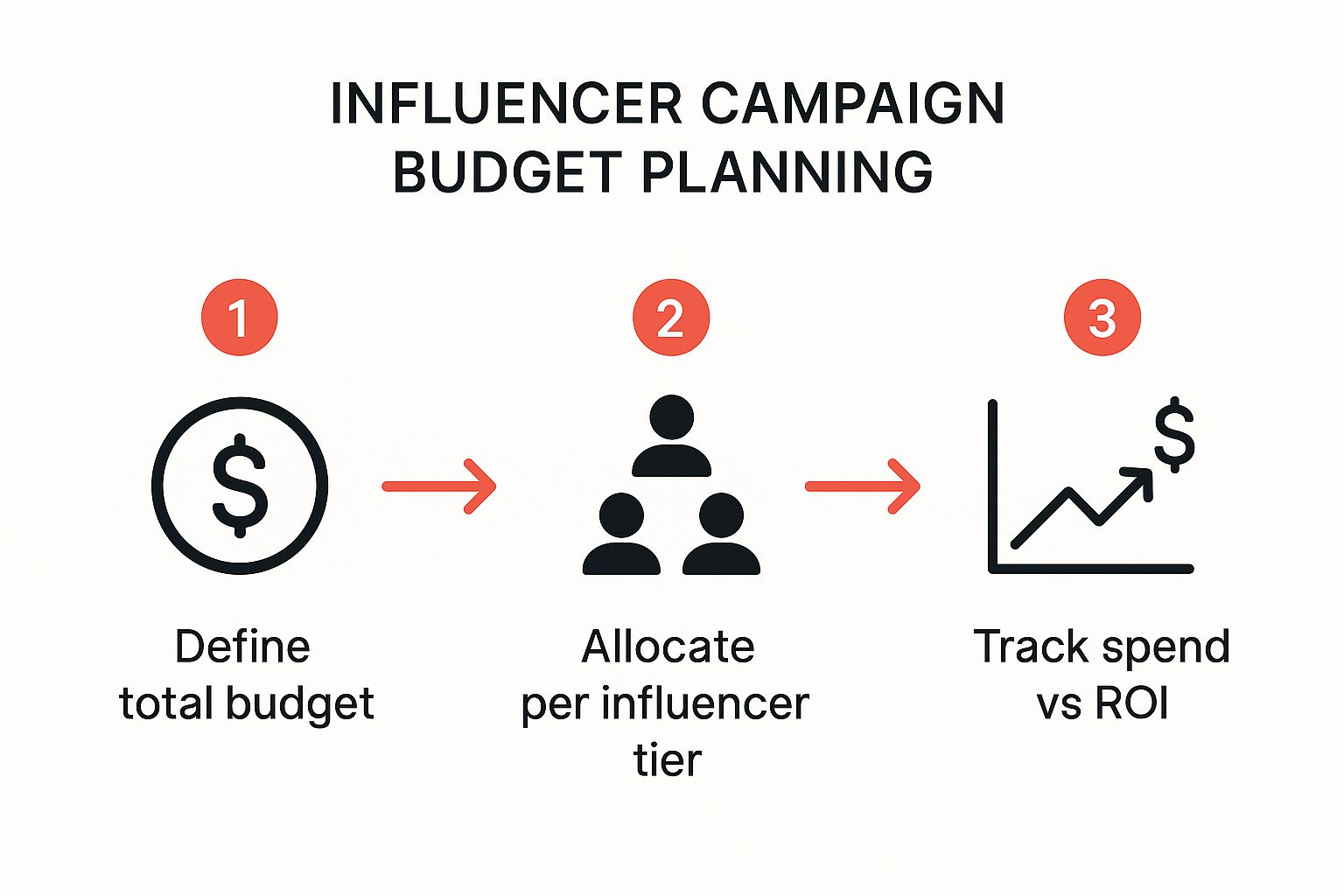
This process isn't just about spending money; it's about investing it strategically. By allocating your funds to the influencer tiers that best match your goals, you set yourself up for measurable, impactful results.
The Art of Finding the Right People
Okay, so you know what you're looking for. But where do you actually find these ideal partners? Building a solid list of potential collaborators is a mix of smart tech, good old-fashioned manual research, and a bit of strategic snooping. Don't just rely on one method.
A great place to start is with dedicated influencer discovery platforms. These tools are your first line of attack, letting you filter creators by niche, audience demographics, engagement rates, and keywords. They can dramatically speed up the initial search. Our guide offers more detail on how to find the right influencers for your brand, providing a deeper dive into these tools: https://joinbrands.com/blog/how-to-find-the-right-influencers-for-your-brand/
But don't stop there. Seriously, don't underestimate manual searching. Dive into hashtags relevant to your industry on TikTok and Instagram. See who is leading conversations and creating killer content that really pops. This hands-on approach often uncovers rising stars before they appear on the big platforms.
Finally, check out your competitors. Who are they working with? Which collaborations seem to be landing well? You're not looking to copy their strategy, but this analysis can reveal proven creators in your niche and highlight potential gaps you can fill. For B2B brands, for instance, you can discover top B2B LinkedIn influencers to find partners who are already experts in your space.
Your Final Vetting Checklist
Once you've got a shortlist, it's time for the final, most crucial step. It's estimated that the sweet spot for micro-influencers is between 5,000 and 20,000 followers—this is often where you find the best balance of reach and stellar engagement.
Before you even think about sending that first outreach email, run every single candidate through this final checklist.
- Brand Alignment: Does their personal brand, tone, and overall vibe actually match your company’s values? Scroll back through their last six months of content. Is it consistent?
- Content Quality: Is their stuff actually good? Look for well-produced, creative, and professional content. Low-quality visuals or lazy posts will make your brand look bad by association.
- Audience Demographics: Do their followers match your target customer? This is non-negotiable. Ask for their media kit, which should have detailed audience analytics.
- Past Partnerships: Have they worked with your direct competitors? Or with brands that totally clash with your values? A history of authentic, selective partnerships is a fantastic sign.
By following this rigorous process, you move beyond simply hiring someone with a lot of followers and start building a true partnership. This is the foundational work that separates forgettable influencer marketing campaigns from the ones that drive real, lasting impact.
Crafting Your Brief and Outreach Strategy
You’ve got your vetted list of creators. Now what? It’s time to build two of the most critical assets for any campaign: a rock-solid campaign brief and a personalized outreach plan.
Honestly, a detailed brief is probably the single most important document you’ll create. It's your North Star. It keeps your team and the creator aligned on every single expectation, deliverable, and goal. Getting this right from the start prevents those painful (and expensive) misunderstandings later on.
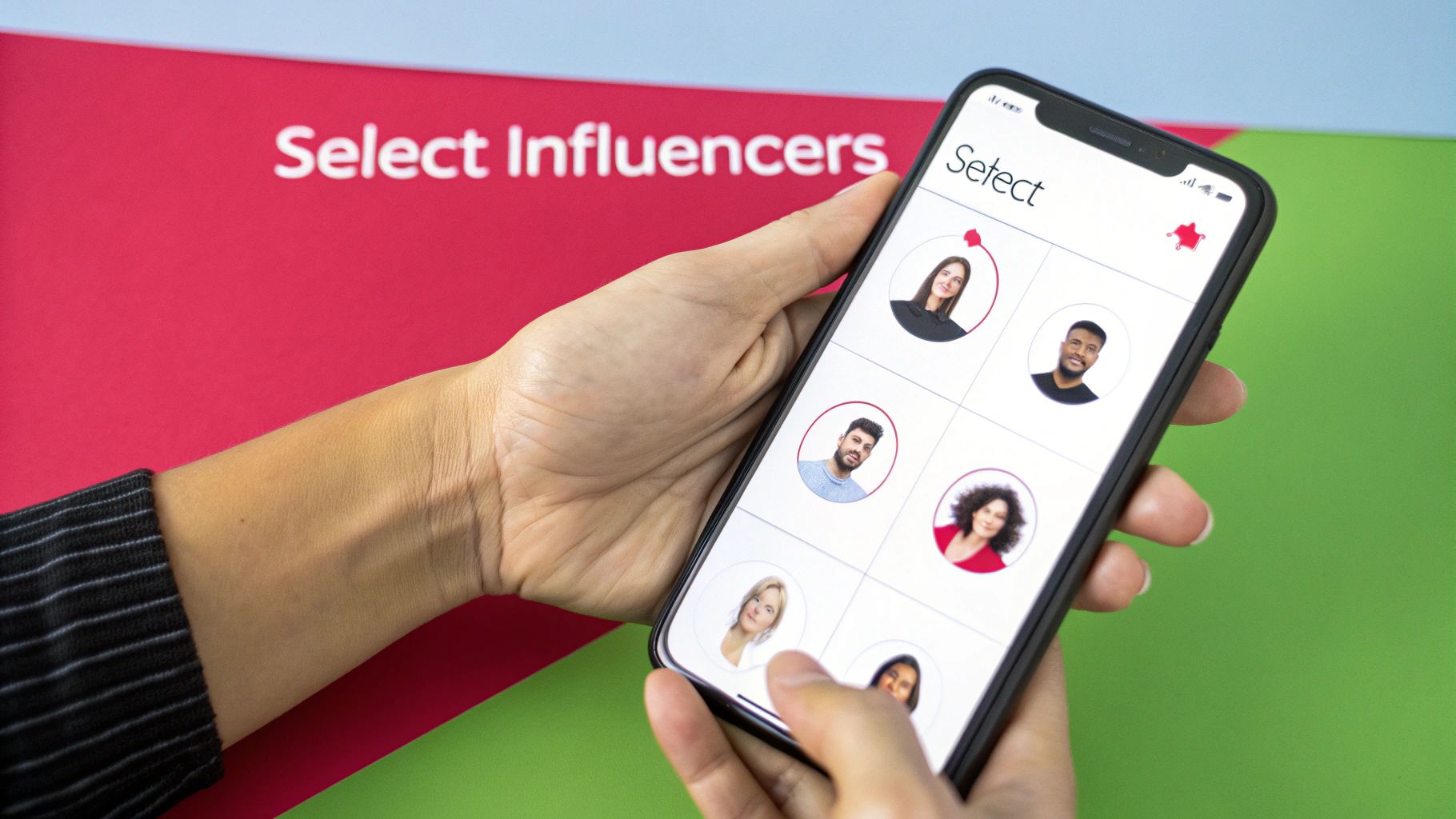
Think of the brief as the blueprint for your collaboration. This isn't about micromanaging or killing their creative spark. It’s about giving them the guardrails they need to produce content that's on-brand, effective, and compliant. A weak brief just leads to endless revisions and disappointing results, while a great one empowers creators to knock it out of the park.
Building a World-Class Influencer Brief
Your brief needs to be comprehensive, but it also has to be easy to scan. Creators are juggling multiple projects, so clarity is everything. Ditch the corporate jargon and focus on giving them exactly what they need to succeed without burying them in details.
Make sure your brief nails these core components:
- Campaign Goals & KPIs: Circle back to the objectives you set earlier. Are you shooting for a specific number of sales? App downloads? A certain engagement rate? Let the creator know precisely what a "win" looks like for this campaign.
- Key Talking Points & Messaging: Give them two or three non-negotiable messages about your product. This might be a standout feature, a core brand value, or the main call-to-action. Hand them the essential points, but trust them to weave it into their own authentic voice.
- Content Deliverables & Platform Specs: Get explicit here. How many posts? What formats? Be crystal clear: one TikTok video, two Instagram Stories, etc. Include any technical must-haves, like video length or aspect ratio.
- Mandatory Elements: This is your checklist section. List any required hashtags (e.g.,
#BrandPartner,#Ad), mentions (@yourbrand), or specific links they absolutely must include in their posts. - Content Usage Rights: Be upfront about how you plan to use their content. Are you going to repurpose it on your website, in email newsletters, or for paid ads? Define the duration of these rights clearly (e.g., 6 months, 1 year).
Pro Tip: The most overlooked part of a brief is the "Dos and Don'ts" section. Seriously, don't skip this. Explicitly list things to avoid—like mentioning a direct competitor, using certain words, or showing the product in a way that doesn't fit the brand. This one small addition will save you from major headaches.
And finally, the big one: clear instructions on FTC disclosure. This is non-negotiable. Remind creators they are legally required to disclose the partnership in a way that's easy for their audience to see. Standard hashtags like #ad or #sponsored are the norm and protect everyone involved.
The Art of Personalized Outreach
With your brief polished and ready, it's time to actually reach out. Let me be blunt: blasting out generic, copy-paste emails is the fastest way to get ignored. Top-tier creators get dozens of pitches every single day. Personalization isn’t a nice-to-have; it's the only way to even get your email opened.
Your first message should be a warm intro, not a cold contract. Show them you’ve done your homework. Mention a specific post or video of theirs you genuinely enjoyed and explain why it made you think they’d be a perfect fit for your brand. Keep it short, respectful, and focused on building a real connection.
Once they show interest, then you can share the full campaign brief and start talking details. Be ready to discuss rates, deliverables, and timelines. Treat it like a conversation between partners, not a list of demands. A fair negotiation is the foundation for a great long-term relationship.
After you’ve agreed on the terms, get it all down in a simple but clear contract. This protects both of you. It should cover everything: deliverables, payment terms, the content approval process, usage rights, and disclosure rules. A solid contract makes sure everyone is on the same page before a single piece of content gets made, setting you up for a smooth and professional campaign from start to finish.
Managing Your Campaign Workflow
Alright, you’ve picked your creators and they’re officially on board. Now the real fun begins. The planning phase is over, and it's time to dive into execution. This is where having a smooth, organized workflow isn't just nice—it's essential for keeping your campaign on track from start to finish.
Think of it as a balancing act. You need to provide clear direction to hit your campaign goals, but you also have to give creators the space to be, well, creative. After all, you hired them for their unique style and authentic connection with their audience, not to be a puppet.
A shared calendar or a simple project management tool is your best friend here. It’s non-negotiable. This becomes the single source of truth for every deadline, from when they need to submit their first draft to the day the final content goes live. This one simple step cuts out so much of the back-and-forth and keeps everyone on the same page.
Navigating Content Review and Approval
The content review process is a delicate dance. Get it wrong, and you can sour a great creator relationship. Your goal is to give helpful, constructive feedback that steers the content toward your brief—not to take over and rewrite their script.
When you give notes, be specific and actionable. Don't just say, "I'm not feeling this part." Instead, try something like, "Could we phrase this key benefit more like X to really highlight the value?" This small change frames your feedback as a collaboration, not a top-down command.
Here's a simple approval flow that works without killing creativity:
- Initial Draft Review: First, just check the basics. Is it aligned with the core message? Does it meet brand safety guidelines? And crucially, does it have the proper FTC disclosures?
- Minor Revisions: Keep your feedback tight. Focus on things like factual accuracy or key brand points, not their creative choices or tone.
- Final Approval: Once everything looks good, give them the green light and confirm the post is ready for the agreed-upon schedule.
This approach gives you the quality control you need without becoming a bottleneck. It also shows creators you value their time and expertise, which is huge for building partnerships that last.
A great brand partner makes the review process feel like a supportive collaboration, not a critical examination. The best content emerges when creators feel trusted and empowered, not micromanaged.
Streamlining Logistics and Amplification
Don't forget the practical details. If you're sending out products, do it efficiently. Ship everything with plenty of lead time before content is due, and always give the creator a tracking number. No one likes guessing when a package will arrive.
Once the content is live, your job isn’t over. Now you switch to monitoring and amplifying. Keep a close eye on the posts as they go up. Track the engagement, of course, but more importantly, read the comments. The audience's feedback is a goldmine of raw, unfiltered insight into how your message is landing.
Want to get more bang for your buck? Take the best-performing posts and put some ad spend behind them. Tools like TikTok's Spark Ads or Instagram's branded content ads are perfect for this. You can push proven, authentic content to a much wider, highly targeted audience. This strategy takes the creator's social proof and puts it on steroids, seriously boosting your campaign's reach and ROI.
Measuring ROI and Optimizing for the Future
Once the last influencer post goes live, your work isn't finished—it’s just entering a new phase. This is where the most successful influencer marketing campaigns separate themselves from the rest. It's time to prove the value of your efforts and turn all that raw data into a smarter strategy for next time.
Forget about fixating on vanity metrics like likes and shares. Sure, they show that something is happening, but they don't tell the whole story. Real success is measured by connecting what an influencer did directly to tangible results for your business.
Moving Beyond Vanity Metrics
To get a real read on performance, you have to circle back to the goals you set at the very beginning. The only way to do that is by tracking key performance indicators (KPIs) that actually reflect business impact—things like conversion rates, click-through rates (CTR), and your cost per acquisition (CPA).
Here are the essential tracking methods you should have in place from day one:
- UTM Parameters: These are special tags you add to the links you give creators. They let you see exactly how much traffic and how many sales came from each specific influencer right inside your analytics dashboard.
- Affiliate Links: Perfect for campaigns laser-focused on sales. These links track every single purchase made through a creator, and you can even tie their pay directly to the revenue they bring in.
- Unique Discount Codes: Assign a distinct code like "CREATOR15" to each influencer. This is one of the easiest and cleanest ways to attribute sales and see which partners are truly moving the needle.
Using these tools lets you precisely measure the financial impact of each creator partnership. This is the bedrock for calculating a true return on investment (ROI). For a deeper dive into the numbers, check out our detailed guide on how to measure influencer marketing ROI.
Key Metrics for Measuring Campaign Success
Tracking the right KPIs is everything. What you measure depends entirely on what you were trying to achieve. Here’s a quick breakdown of which metrics to focus on based on your campaign goals.
| Campaign Goal | Primary KPIs | How to Track It |
|---|---|---|
| Brand Awareness | Impressions, Reach, Mentions, Share of Voice | Influencer reporting, social listening tools, platform analytics |
| Engagement | Likes, Comments, Shares, Saves, Clicks, Engagement Rate | Platform analytics, third-party analytics tools |
| Conversions | Sales, Leads, App Installs, Sign-ups, CPA, ROAS | UTM parameters, discount codes, affiliate links, pixel tracking |
By aligning your measurement strategy with your initial objectives, you get a crystal-clear picture of what's working and what isn't.
Compiling and Analyzing Your Campaign Report
After the campaign wraps up, it’s time to pull all your data into one comprehensive report. This document isn't just for showing off your wins; it's a critical tool for learning and getting better. To truly understand the performance and impact of your collaborations, you need robust Influencer Marketing Analytics.
Your report should clearly analyze what worked, what flopped, and most importantly, why. Get critical. Which creator drove the highest-quality traffic? Did Reels outperform static images? Was one call-to-action way more effective than the others?
A campaign report is more than a summary of past events; it's a roadmap for the future. The insights you uncover from a single campaign can drastically improve the performance of every single one that follows.
This analysis is where you find the gold. You might discover that your audience went crazy for unboxing videos from micro-influencers but completely ignored polished posts from larger creators. That kind of insight is invaluable, allowing you to reallocate your budget way more effectively next time.
By turning data into actionable intelligence, you ensure that every campaign is not just a standalone project, but a stepping stone to smarter, more impactful marketing.
Your Top Influencer Marketing Questions Answered
When you're diving into the world of influencer marketing campaigns, a few questions always seem to pop up. Let's be honest, they're the tricky ones, but getting them right is what separates a smooth, professional partnership from a messy one.
How Much Should I Actually Pay an Influencer?
This is the million-dollar question, isn't it? The truth is, rates are all over the place. They depend on everything from follower count and engagement to their specific niche and what you're asking them to create.
A common starting point you'll hear about is the 1% rule—which suggests budgeting around $100 for every 10,000 followers. But treat that as a loose guideline, not a hard-and-fast rule.
Before you even think about making an offer, get your hands on the creator's media kit and look at their past campaign performance. For nano-influencers with those tight-knit, super-engaged communities, sometimes offering free products (product seeding) is a great way to start, especially if your product is something they'd be genuinely excited about.
Think of it less like a transaction and more like a partnership negotiation. Start with a fair, data-backed offer, but stay flexible. The goal is a compensation package that feels like a win for both of you.
What's the Difference Between Usage Rights vs. Ownership?
Getting this wrong can lead to some serious legal headaches down the road, so it's crucial to understand the distinction.
- Usage Rights: This is the standard deal. It gives you permission to use the creator's content on specific channels (like your website or in social ads) for an agreed-upon amount of time. It's cost-effective and covers what most brands need.
- Ownership: This means you're buying the content outright. You get to use it forever, wherever you want. As you can imagine, this is much more expensive and pretty rare for typical influencer campaigns.
How Do We Handle Negative Comments?
First thing's first: don't panic. Take a breath and look at where the comment is coming from. If it's legitimate, constructive feedback, engaging politely can actually turn a negative into a huge positive for your brand's image.
But if it's just spam, trolls, or straight-up abuse? Let the creator handle their own community. They know how to manage it best, whether that means deleting the comment or blocking the user. Whatever you do, never get dragged into an argument in the comments.
Ready to put all this into action without the headache? With JoinBrands, you can find vetted creators, manage briefs, handle content approvals, and track your ROI—all from one dashboard. Find the perfect partners for your brand and launch your next campaign today.
